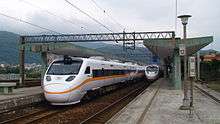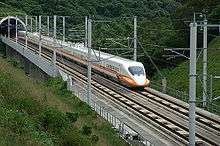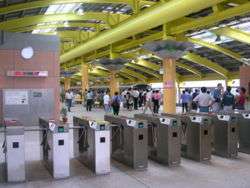Rail transport in Taiwan
| Taiwan | |
|---|---|
| Operation | |
| National railway | Taiwan Railways Administration |
| Major operators | Taiwan High Speed Rail |
| Statistics | |
| Ridership | 287 million[1] (2016) |
| Passenger km | 21.5 billion[1] (2016) |
| System length | |
| Total | 1,418 km (881 mi) |
| Double track | 1,077 km (669 mi) |
| Electrified | 1,240 km (770 mi) |
| High-speed | 354 km (220 mi) |
| Track gauge | |
| Main | 1,067 mm (3 ft 6 in) |
| High-speed | 1,435 mm (4 ft 8 1⁄2 in) |
| 1,067 mm (3 ft 6 in) | 1,065 kilometres (662 mi) |
| 1,435 mm (4 ft 8 1⁄2 in) | 513 kilometres (319 mi) |
| Features | |
| Longest tunnel |
Xinguanyin Tunnel 10.3071 kilometres (6.4045 mi) |
| Longest bridge |
THSR Changhua-Kaohsiung Viaduct 157.317 kilometres (97.752 mi) |
Rail transport in Taiwan consists of 1691.8 km (as of 2015) of railway networks.[2] Though no longer as dominant as it once was, rail transport is an extremely important form of transportation in Taiwan due to high population density, especially along the densely populated western corridor. In 2016, over 1.09 billion passengers traveled by rail in Taiwan, averaging 2.99 million passengers per day.[3]
The railways of Taiwan include conventional rail, rapid transit systems, and high-speed rail, as well as specialized railways for tourists and industry. Taiwan Railways Administration is an associate member and Taiwan High Speed Rail is an active member of the International Union of Railways (UIC), even though Taiwan does not have state membership.
Rail transport was introduced to Taiwan in 1891 during its late Qing era. Push car railways were brought to Taiwan during Japanese rule and were in general service from 1895 to the late 1940s.
All railway services are located in the main island of Taiwan. Outer islands including Penghu, Kinmen, and Matsu Islands do not have railways.
Intercity railways
There are two railway systems that provide intercity transportation service in Taiwan:
| Name | Taiwan Railways | Taiwan High Speed Rail |
|---|---|---|
| Logo |  | |
| Chinese | 臺灣鐵路 | 台灣高速鐵路 |
| Taiwanese | Tâi-oân Thih-lō͘ | Tâi-ôan Ko-sok Thih-lō͘ |
| Hakka | Thòi-vân Thiet-lu | Thòi-vàn Kaû-suk Thiet-lu |
| Service type | Inter-city rail, Commuter rail | Inter-city rail, High-speed rail |
| Date opening | 1891 | 5 January 2007 |
| Gauge | 1,067 mm (3 ft 6 in) | 1,435 mm (4 ft 8 1⁄2 in) |
| No. of lines | 3 main, 10 branches | 1 |
| No. of stations | 227 | 12 |
| System length | 1,114.5 km (693 mi) | 349.5 km (217 mi) |
The Taiwan Railways is administered by the governmental agency Taiwan Railway Administration. TRA operates both passenger service and the only freight service in the country. The main lines form a loop around the island that connect most of the country's major cities, with small branch lines at various points to the interior. TRA operates both intercity trains throughout Taiwan, and commuter services into the major cities. The Taiwan High Speed Rail is operated by a franchised private company called Taiwan High Speed Rail Corporation, it contains passenger services between Nangang, Taipei and Zuoying, Kaohsiung with a route that runs through Western Taiwan.
 A TRA Taroko Express train stands at Toucheng Station as another pulls alongside |
 A THSR train on a test run in 2006 |
 A TRA Tzu-Chiang Limited Express at Tainan Station |
Rapid transit
There are five Urban rail transit systems that provide rapid transit service in five major municipalities of Taiwan:
| Name | Kaohsiung MRT | New Taipei Metro | Taichung Metro | Taipei Metro | Taoyuan Metro |
|---|---|---|---|---|---|
| Logo | .svg.png) | .svg.png) | .svg.png) |  | |
| Chinese | 高雄捷運 | 新北捷運 | 臺中捷運 | 臺北捷運 | 桃園捷運 |
| Taiwanese | Ko-hiông Chia̍t-ūn | Sin-pak Chia̍t-ūn | Tâi-tiong Chia̍t-ūn | Tâi-pak Chia̍t-ūn | Thô-hn̂g Chia̍t-ūn |
| Hakka | Kô-hiùng Chhia̍p-yun | Sîn-pet Chhia̍p-yun | Thòi-chûng Chhia̍p-yun | Thòi-pet Chia̍p-yun | Thò-yèn Chhia̍p-yun |
| Service area | Kaohsiung | Tamsui, New Taipei | Taichung | Taipei, New Taipei | Taoyuan, Taipei, New Taipei |
| Date opening | 9 March 2008 | December 2018 | December 2018 | 28 March 1996 | 2 March 2017 |
| No. of lines | 2 MRT, 1 LRT | 1 LRT | 1 MCS | 4 MRT, 1 MCS | 1 MRT |
| No. of stations | 52 | 14 | 18 | 117 | 21 |
| System length | 51.4 km (32 mi) | 13.99 km (9 mi) | 16.71 km (10 mi) | 131.2 km (82 mi) | 51.03 km (32 mi) |
Most of the urban rail transit systems use standard gauge 1,435 mm (4 ft 8 1⁄2 in), except Taipei Metro Wenhu line, which uses VAL system with 1,880 mm (6 ft 2 in) track gauge. The main line of Taoyuan Metro is called the Taoyuan Airport MRT, which connects Taoyuan International Airport, Taiwan's largest airport, with Taipei and Zhongli, Taoyuan. In addition to the five systems above, there were also plans to built rapid transit systems in municipalities of Tainan and Hsinchu. However, the Ministry of Transportation and Communications declined the proposals in January 2010 for budget issues and deeming it premature.[4] Recently, most plans of new urban rail transit system plans have adopted light rail for budget efficiency.
 Xiaobitan Station on the Taipei Metro |
Formosa Boulevard Station's "Dome of Light" on the Kaohsiung MRT |
Industrial and tourist railways

Originally built for the transportation of industrial products, these railroads have become tourist attractions.[5][6][7]
- Alishan Forest Railway: A narrow gauge railway that runs from Chiayi City to the popular mountain resort of Alishan. Originally built by the Japanese Colonial Government for the logging industry in 1912, this line now caters mostly to tourists.
- Taiwan Sugar Railways: An extensive series of narrow gauge lines mostly in central and southern Taiwan, originally built to haul sugarcane by Meiji Sugar Co., Ltd. during Japanese rule, but also capable of providing limited passenger service. Regular passenger services discontinued in 1982. In 2003, some short-distance train services resumed.
- Taiping Mountain Forest Railway: A short 3 km (1.9 mi), narrow gauge rail line running through the Taiping Mountain Scenic Area in Yilan County, originally constructed in 1924 for the logging industry, now a popular tourist attraction.
- A 3.9 km long section of the Luodong Forest Railway (Chinese: 羅東森林鐵路) near Tien-sung-pi railway station is being recommissioned as a tourist train.
- Wulai Scenic Train: A short 1.6 km rail line running through mountains in Wulai District in New Taipei, originally constructed for logging and timber industry, now a popular tourist attraction.
Track gauge
The earliest railway in Taiwan was completed in 1893 under the auspices of Governor Liu Mingchuan during the Qing Era and rebuilt by the Governor-generals during the Japanese Era (see Taiwan Railways Administration§History). Since then, major railways in Taiwan have followed the 3 ft 6 in (1,067 mm) gauge standard. The Hualien–Taitung Line was built during the Japanese Era with 2 ft 6 in (762 mm) gauge, but since 1982 it has been converted to 3 ft 6 in (1,067 mm), while the Alishan Forest Railway and the majority of Taiwan Sugar Railways are still 2 ft 6 in (762 mm) railways. The Taiwan High Speed Rail and all rapid transit systems use standard gauge track.
Cultural
Because of the Taiwan's extensive rail network (including many now defunct industrial narrow gauge lines which provided passenger service to rural areas), railways in Taiwan often have a romantic connotation, especially amongst the older generation who remember growing up when rail travel was the primary means of transportation between cities in simpler (and less prosperous) times. Many remember leaving their hometowns to attend school in far away cities by train or leaving via train to perform their compulsory military service. This nostalgia has been capitalized upon in recent years through the introduction of various items such as "nostalgia railroad ekiben" (懷舊鐵路便當), claimed to be authentic copies of the box lunches that were once served aboard trains.
There is also a sizable network of railway fans in Taiwan which has increased with the recent trend of Taiwanization.
See also
References
- 1 2 "鐵路重要參考指標統計表". Ministry of Transportation and Communication, ROC (in Chinese). Retrieved 1 December 2017.
- ↑ TRA+THSR+MRTs only
- ↑ "Table 2-1 Passenger Traffic of Railway in Taiwan Area". Ministry of Transportation and Communications. Retrieved 2017-08-01.
- ↑ "捷運夢碎!八條輕軌遭退回!公車難經營 捷運路遙遠 台灣大眾運輸 阻礙重重!(MRT Dreams Shattered, Eight Light Rail System Proposals Declined)". Public Television Service. 19 January 2010. Archived from the original on 25 April 2012. Retrieved 20 October 2011.
- ↑ "Taiwan Train Travel". AsiaRooms.com. Retrieved 2010-07-02.
- ↑ "Places to Visit". Council of Agriculture, Executive Yuan. Archived from the original on 9 October 2011. Retrieved 2 July 2010.
- ↑ "Nature". Taiwan.com.au. Archived from the original on 1 December 2008. Retrieved 2 July 2010.
External links
| Wikimedia Commons has media related to Railways of Taiwan. |
